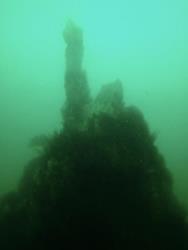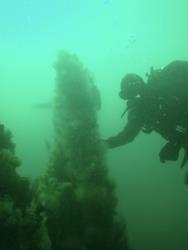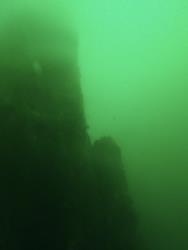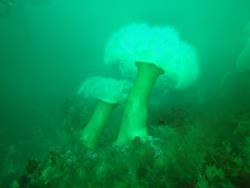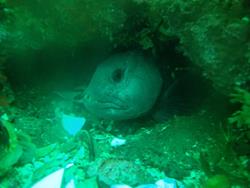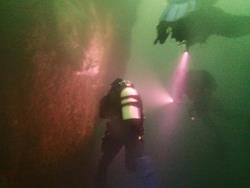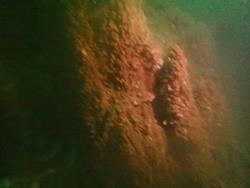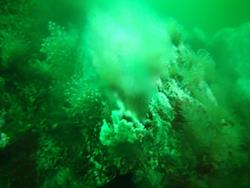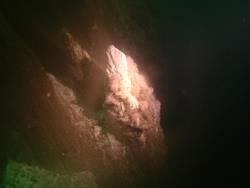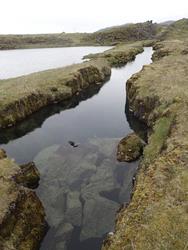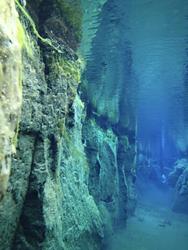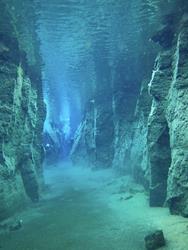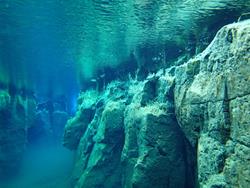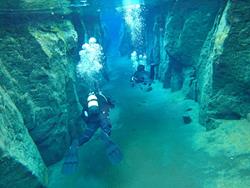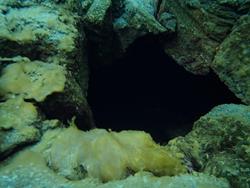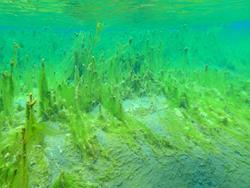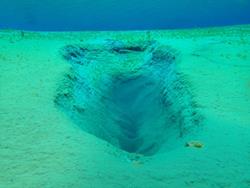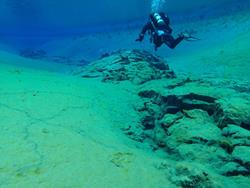DIVING IN NORTHERN ICELAND by Andrew Falconer
Iceland is already pretty far north, lying just below the Arctic Circle, but in the north of the country are two very different and interesting dive sites.
STRYTON GEOTHERMAL CHIMNEY
This vertical geothermal chimney rises from a depth of about 60m from the floor of Eyjafjordur fjord about 30km north of Akureyri to about 20m below the surface, and is the one of the few known dive able ones in the world, most being beyond diving depth on the ocean floor. It was discovered in the 1980s and is now a declared protected zone, with responsibility for protection given to Erlendor Bogason, a local diver and conservationist who leads recreational diving on it.
|
The top is about 20m deep |
Diver beside the top |
The vertical side of the pinnacle |
Needless to say the sea temperature in northern Iceland is cold, around 7 degrees, even in summer and a dry suit is mandatory. Erlendor can supply all equipment and takes divers the short distance out into the fjord in an inflatable in small groups (max six) from his base at an old herring factory at Hjalteyri. To dive Strytan you need to be an experienced dry suit diver, as it can be quite adventurous at depth.
|
There is life in the transitional zone around the pinnacle |
From a buoy near the chimney the top of the chimney is reached at about 20m where the light is still good even if the water is rather green. As you descend deeper the light diminishes and a torch is handy.
|
As one descends deeper the light fades |
The steep sides of the pinnacle illuminated |
Hot (80 degrees fresh water flows out of vents on the chimney at an estimated rate of 100 litres per second, and can be seen mixing with the cold sea water. The active vents can also be identified by the white fresh calcium / magnesium salt deposits around them from contact with the cold seawater.
|
Fresh hot water flowing out of a vent |
The vents are indicated by white rock |
The vent water can actually be collected in a flask and used to make a cup of hot chocolate after the dive. Care must be taken while diving, as the chimney is fragile in places and should not be touched.
NESGJA CONTINENTAL RIFT
The “dive between the continents” at Silfra in the south west of Iceland has become a major tourist attraction and is visited by thousands of snorkelers and divers each year. Far less known and dived is Nesgja, which is also part of the same continental rift and has similar crystal clear (and cold 2 degrees) water.
|
View of the rift from above |
two views of the rift from below showing water clarity |
The Nesgja site is located a few hours drive north east from Akureyri on farmland close to the coast, and consists of a channel several hundred meters long which then connects to a lake. Erlendor drove myself and two other divers there for a trip that lasted a day and also included a warm water lake (no dry suit required) and a waterfall.
|
Crystal clear water and algae on the rocks |
Divers swimming along the rift |
There is a gentle current along the channel into the lake. One enters the channel from the rocks and you need to be careful not to stir up any of the algae that grow on the rocks and bottom. The channel is not deep and has a sandy bottom. As can be seen from the photos, the water at Nesgja is crystal clear and it is quite an experience to swim through it along the passage as it feels like you are floating in air rather than water. The passage terminates in a shallow area, which is covered in a field of green algae, and then enters a lake, which also has a sandy bottom.
|
A dark hole going downwards into the earth |
Between the rift and the lake is a field of algae |
The water in the lake is also crystal clear and there are many places where water is coming up from below making craters in the sandy floor, with sand bubbling up in the depressions.
|
A vent in the sand bottom of the lake |
The rift follows a channel through the lake |
Iceland is an amazing place both above and below the water, and is now attracting many tourists and cruise boats, but it is also one of the most expensive countries in the world, and likewise the diving does not come cheap. Two dives on Strytan and the trip to Nesgja with hire of gear cost me $800, however it is a unique and personalized experience to dive these sites with Erlendor. You can find out more at www.strytan.is
JUNE 2017
 Northern Iceland
Northern Iceland Galapagos Islands
Galapagos Islands 